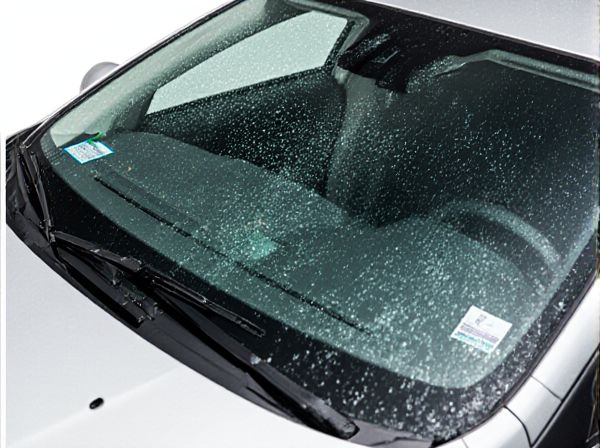
Photo illustration: Rain Sensor Windshield vs Conventional Windshield
A rain sensor windshield automatically detects moisture and activates the wipers, providing convenience and improved visibility without manual adjustment. Conventional windshields require you to activate windshield wipers manually, which can be less efficient during sudden weather changes. Investing in a rain sensor windshield enhances safety by responding promptly to rain, allowing you to focus more on driving.
Table of Comparison
| Feature | Rain Sensor Windshield | Conventional Windshield |
|---|---|---|
| Functionality | Automatically detects rain and activates wipers | Requires manual wiper activation |
| Safety | Improves visibility during rain without driver intervention | Dependent on driver response time |
| Technology | Embedded rain sensors and smart glass technology | Standard laminated glass without sensors |
| Cost | Higher upfront cost due to sensor integration | Lower initial cost, widely available |
| Maintenance | Requires sensor calibration and occasional cleaning | Minimal maintenance, mainly cleaning |
| Comfort | Enhances driving comfort by reducing manual adjustments | Driver must manually adjust wipers during rain |
Introduction to Rain Sensor Windshields
Rain sensor windshields use embedded sensors to detect moisture levels on the glass, automatically activating windshield wipers for improved visibility during rain. Unlike conventional windshields that require manual wiper operation, rain sensor technology enhances driver convenience and safety by responding instantly to changing weather conditions. This adaptive feature integrates optical or capacitive sensors, making it a valuable advancement in automotive design.
How Rain Sensor Windshields Work
Rain sensor windshields use optical sensors embedded in the glass to detect moisture levels, automatically activating windshield wipers when rain or water droplets are present. Conventional windshields rely on manual wiper control, requiring driver input to adjust speed and timing based on visibility conditions. The technology in rain sensor windshields enhances driving safety by responding promptly to changing weather while reducing driver distraction.
Mechanism of Conventional Windshields
Conventional windshields rely on manual operation using a wiper motor connected to a series of linkages that move the wiper blades across the glass surface at adjustable speeds. The system typically includes a control stalk or switch that allows the driver to select wiper settings such as intermittent, slow, or fast wiping intervals. Unlike rain sensor windshields, conventional models lack automatic detection and rely entirely on driver input to maintain clear visibility during precipitation.
Key Differences Between Rain Sensor and Conventional Windshields
Rain sensor windshields automatically detect moisture and activate windshield wipers, enhancing driver convenience and safety by maintaining clear visibility without manual input. Conventional windshields require manual operation of wipers, which can lead to delayed responses during sudden rain events and decreased driving safety. The integration of rain sensor technology in windshields reduces driver distraction and improves reaction time by providing real-time environmental adjustments.
Advantages of Rain Sensor Windshields
Rain sensor windshields enhance driving safety by automatically activating windshield wipers when moisture is detected, providing immediate response to changing weather conditions. These smart windshields reduce driver distraction and maintain optimal visibility without manual adjustment, improving overall driving comfort. Unlike conventional windshields that require manual wiper control, rain sensor windshields optimize performance with precise sensitivity settings, conserving wiper blade life and ensuring efficient water removal.
Limitations of Rain Sensor Windshields
Rain sensor windshields rely on optical sensors that detect moisture levels to automatically activate wiper systems, but they can struggle with accuracy in heavy fog, dirt buildup, or when coated with certain tints and treatments, leading to inconsistent performance. These sensors may also fail to recognize light rain or intermittent splashes, causing delayed or unnecessary wiper activation. In contrast, conventional windshields paired with manual wipers provide consistent control unaffected by sensor limitations, though they require driver intervention and attention.
Cost Comparison: Rain Sensor vs Conventional Windshields
Rain sensor windshields typically cost between $400 and $800, reflecting the advanced technology and integrated sensors, whereas conventional windshields range from $150 to $350 depending on size and vehicle model. Installation expenses for rain sensor windshields are also higher due to the complexity of sensor calibration, often adding $100 to $200 compared to standard windshield installations. Over time, rain sensor windshields can offer cost savings by reducing wear from improper wiper usage, but the initial investment remains significantly greater than conventional options.
Maintenance and Durability Factors
Rain sensor windshields feature embedded sensors that automatically activate wipers, reducing manual adjustments and potential wear on wiper blades, which extends overall maintenance intervals compared to conventional windshields. Conventional windshields require regular manual activation of wipers, increasing the likelihood of inconsistent usage and faster deterioration of both windshield glass and wiper components. Durability of rain sensor windshields may be slightly higher due to the integrated technology minimizing mechanical stress, while conventional windshields rely solely on user input, potentially leading to faster wear under harsh weather conditions.
Impact on Driving Safety and Convenience
Rain sensor windshields enhance driving safety by automatically detecting moisture and activating wipers, reducing driver distraction during sudden rain showers. They improve convenience through consistent visibility adjustments without manual intervention, ensuring optimal windshield clarity at all times. Conventional windshields require manual wiper control, which can delay reaction times and increase the risk of impaired vision in adverse weather conditions.
Choosing the Right Windshield for Your Vehicle
Rain sensor windshields offer automatic wiper activation by detecting moisture, enhancing driving safety in wet conditions compared to conventional windshields that require manual wiper control. Choosing the right windshield depends on factors such as vehicle compatibility, driving environment, and budget considerations, with rain sensor models generally favored for convenience and advanced technology. Prioritize manufacturer recommendations and sensor calibration for optimal performance when selecting between rain sensor and conventional windshields.
 caratoz.com
caratoz.com